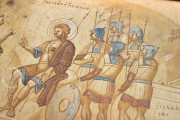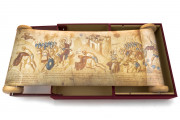The illustrated scroll of the Old Testament book of Joshua known as the Joshua Roll is a masterwork of the Byzantine manuscript tradition. Although the Joshua Roll has been the focus of many studies and lively debate, the purpose and function of the scroll remain disputed. The Joshua Roll contains and illustrates passages from the Greek Septuagint version of the book of Joshua.
Although the roll only offers about half of the scriptural text due to losses at the beginning and end, its content is nonetheless remarkable. Thirty-six monumental scenes run continuously across the length of the scroll.
A Subtle Palette
A limited palette characterizes the dynamic narrative images. Ocher, blue, and purples are used to highlight otherwise monochromatic renderings. Gradations of value convey depth, mass, and movement in the figures. The simple colors and spare execution—appropriate to the roll format, which invites flexing of the parchment support—bestow an ethereal atmosphere to the scenes.
Tenth-Century Revival of an Antique Form
The images on the roll are not formally divided but flow one after another separated only by an architectural or landscape element. The rotulus form is one of the work's most surprising features since rolls were uncommon across Greek and Latin manuscript production by the tenth century.
The Joshua Roll appears to be a copy of an earlier scroll. The text features gaps in some places, which suggests that parts of the older work were difficult for the scribe to decipher.
Redacted Text in the Service of Image
The text is written on the lower part of the scroll, chronicling the narrative of the great leader of the Israelites and giving scholars several clues regarding the roll's production and the priorities of its patron. At times the text lines appear to follow the contours of some of the figures, which indicates that the text was written after the execution of the miniatures. The text represents a choice of selected passages edited to fit and function as supporting commentary to the images.
Majuscule Writing
The cursive Greek Majuscule used for the biblical narrative appears to be the work of a single scribe, while the additional captions written in a calligraphic Greek Uncial might be attributable to the Basileios kalligraphos (Basil the scribe), whose name is found in an inscription on the verso.
A Celebration of Military Victory?
The impetus behind the creation of the Joshua Roll remains unclear, but several clues can be mined from the miniatures. Scholars have linked the roll's theme of military accomplishment and strong leadership to Byzantine victories that may have closely predated the scroll. Some have proposed that the roll was made at the behest of Basil the Parakoimomenos, a military leader and documented art patron.
A Study for a Triumphal Column?
Scholars have suggested that Basil commissioned a luxurious copy of an older scroll to serve not only as a display piece but also as a preparatory study for a triumphal column since its size incrementally increases as it unfurls. A series of carved ivory panels in the Metropolitan Museum of Art and the Victoria and Albert Museum appear to copy several of the scroll's compositions, suggesting the roll's availability as a model for artists working in a variety of media.
In Italy by 1500
The Joshua Roll remained in Constantinople until the thirteenth century. Although it is unclear how it got there, the roll appeared in Italy by about 1500. Some of its most notable owners include Niccolò Leonico Tomeo, a scholar of Greek and philosophy, and Ulrich Fugger of the renowned banking family.
The roll became part of the Bibliotheca Palatina in the second half of the sixteenth century. Most of this collection was later incorporated into the Vatican library. The roll's fifteen sheets were detached from each other in 1902.
We have 1 facsimile edition of the manuscript "Joshua Roll": Josua-Rolle facsimile edition, published by Akademische Druck- u. Verlagsanstalt (ADEVA), 1984
Request Info / Price


















